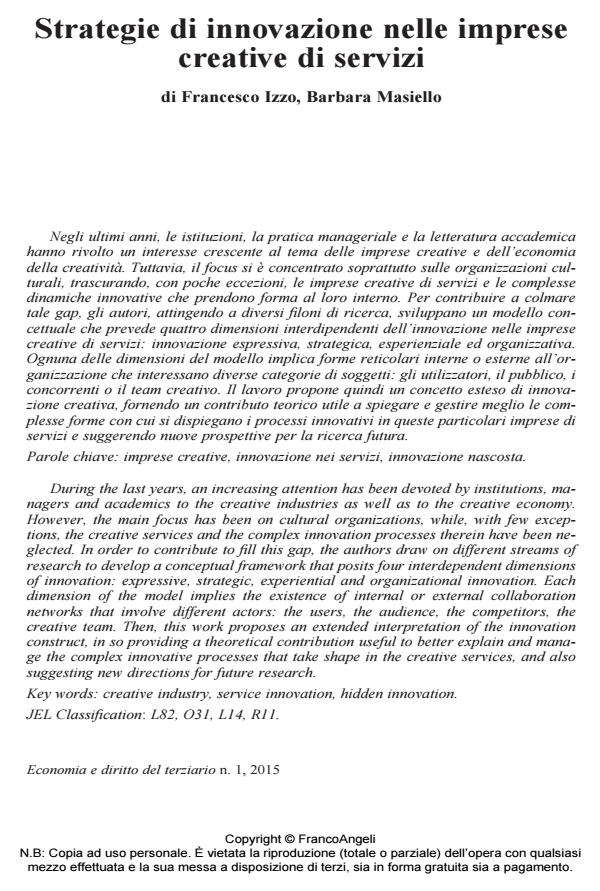Strategie di innovazione nelle imprese creative di servizi
Titolo Rivista ECONOMIA E DIRITTO DEL TERZIARIO
Autori/Curatori Francesco Izzo, Barbara Masiello
Anno di pubblicazione 2015 Fascicolo 2015/1
Lingua Italiano Numero pagine 42 P. 63-104 Dimensione file 201 KB
DOI 10.3280/ED2015-001004
Il DOI è il codice a barre della proprietà intellettuale: per saperne di più
clicca qui
Qui sotto puoi vedere in anteprima la prima pagina di questo articolo.
Se questo articolo ti interessa, lo puoi acquistare (e scaricare in formato pdf) seguendo le facili indicazioni per acquistare il download credit. Acquista Download Credits per scaricare questo Articolo in formato PDF

FrancoAngeli è membro della Publishers International Linking Association, Inc (PILA)associazione indipendente e non profit per facilitare (attraverso i servizi tecnologici implementati da CrossRef.org) l’accesso degli studiosi ai contenuti digitali nelle pubblicazioni professionali e scientifiche
Negli ultimi anni, le istituzioni, la pratica manageriale e la letteratura accademica hanno rivolto un interesse crescente al tema delle imprese creative e dell’economia della creatività. Tuttavia, il focus si è concentrato soprattutto sulle organizzazioni culturali, trascurando, con poche eccezioni, le imprese creative di servizi e le complesse dinamiche innovative che prendono forma al loro interno. Per contribuire a colmare tale gap, gli autori, attingendo a diversi filoni di ricerca, sviluppano un modello concettuale che prevede quattro dimensioni interdipendenti dell’innovazione nelle imprese creative di servizi: innovazione espressiva, strategica, esperienziale ed organizzativa. Ognuna delle dimensioni del modello implica forme reticolari interne o esterne all’organizzazione che interessano diverse categorie di soggetti: gli utilizzatori, il pubblico, i concorrenti o il team creativo. Il lavoro propone quindi un concetto esteso di innovazione creativa, fornendo un contributo teorico utile a spiegare e gestire meglio le complesse forme con cui si dispiegano i processi innovativi in queste particolari imprese di servizi e suggerendo nuove prospettive per la ricerca futura.
Parole chiave:Imprese creative, innovazione nei servizi, innovazione nascosta
Jel codes:L82, O31, L14, R11
- A Creative Approach for the Architectural Technology: Using the ExtrArtis Model to Regenerate the Built Environment Francesca Ciampa, in Sustainability /2023 pp.9124
DOI: 10.3390/su15119124 - New Metropolitan Perspectives Gaia Daldanise, Eleonora Giovene di Girasole, Simona Stella, Massimo Clemente, pp.167 (ISBN:978-3-030-48278-7)
Francesco Izzo, Barbara Masiello, Strategie di innovazione nelle imprese creative di servizi in "ECONOMIA E DIRITTO DEL TERZIARIO " 1/2015, pp 63-104, DOI: 10.3280/ED2015-001004